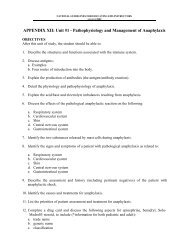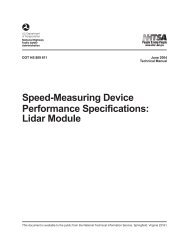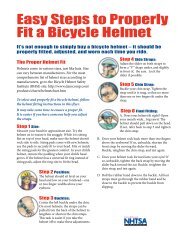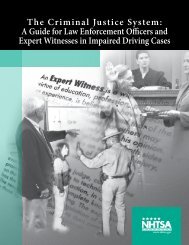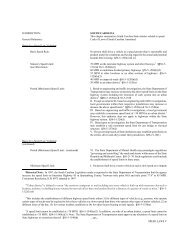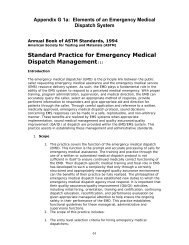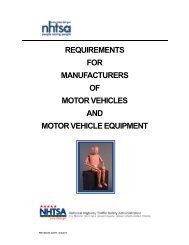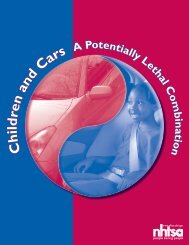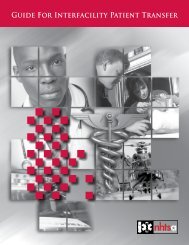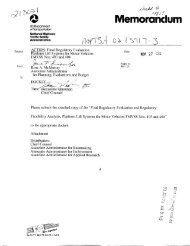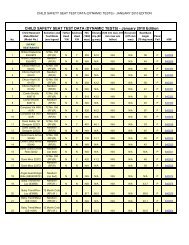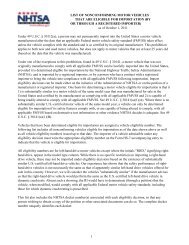Summary of State Speed Laws - NHTSA
Summary of State Speed Laws - NHTSA
Summary of State Speed Laws - NHTSA
You also want an ePaper? Increase the reach of your titles
YUMPU automatically turns print PDFs into web optimized ePapers that Google loves.
JURISDICTION: MONTANA<br />
General Reference: Montana Code Annotated and Administrative Rules <strong>of</strong><br />
Montana<br />
Basis for a <strong>Speed</strong> Law Violation:<br />
Basic <strong>Speed</strong> Rule: Subject to the (maximum) statutory speed limits below, a<br />
person shall operate a vehicle in a careful and prudent manner<br />
and at a reduced rate <strong>of</strong> speed no greater than is reasonable<br />
and prudent under the conditions existing at the point <strong>of</strong><br />
operation, taking into account the amount and character <strong>of</strong><br />
traffic, visibility, weather and roadway conditions. 268 §61-8-<br />
303(4)<br />
Statutory <strong>Speed</strong> Limit: 75 mph 269 at all times on Federal-Aid interstate highways<br />
outside an urbanized area with population ≥50,000. §61-8-<br />
303(1)(a)<br />
65 mph 2 at all times on Federal-Aid interstate highways within<br />
an urbanized area with a population ≥50,000. §61-8-303(1)(a)<br />
70 mph during the daytime 270 and 65 mph during the<br />
nighttime on any other public highway. §61-8-303(1)(b)<br />
65 mph at all times on U.S. Highway 93 between the<br />
Canadian and Idaho boarders unless the highway is upgraded<br />
to a continuous four-lane highway. §61-8-303(2)<br />
25 mph in an urban district. §61-8-303(5)<br />
SPEED 2005<br />
Posted (Maximum) <strong>Speed</strong> Limit: I. The <strong>State</strong> Department <strong>of</strong> Transportation, based on<br />
engineering and traffic investigations which indicate that a<br />
greater or less speed limit than noted above is reasonable or<br />
safe, may establish different speed limits on a segment <strong>of</strong> a<br />
highway less than 50 miles in length. §61-8-309(1) The law<br />
does not specifically state whether different highway speed<br />
limits may be established for different types <strong>of</strong> vehicles, for<br />
various weather conditions, or for different times <strong>of</strong> the day.<br />
II. Based on engineering and traffic investigations, the <strong>State</strong><br />
may establish safe maximum speed limits for bridges or other<br />
elevated structures. §61-8-313(2) and (3)<br />
III. Based on engineering and traffic investigations, a local<br />
government may increase or decrease the maximum speed<br />
limits on highways under its jurisdiction. 271 §61-8-310(1)<br />
268 IMPORTANT: The <strong>State</strong> Supreme Court has held that certain provisions <strong>of</strong> the <strong>State</strong>’s previous basic speed rule were<br />
void for vagueness under the due process clause <strong>of</strong> the <strong>State</strong>’s constitution. <strong>State</strong> v. Stanko, 974 P.2d 1132 (Mont. 1998)<br />
269 When traveling on a two lane road, a person may exceed this speed limit by 10 mph in order to overtake and pass another<br />
vehicle. §61-8-303(3)<br />
270 "Daytime" means one-half hour before sunrise to one-half hour after sunset. "Nighttime" means any other hour except<br />
daytime. §61-8-303(6)<br />
271 I. However, the following limitations apply. (1) The posted speed limit in an urban district cannot be >65 mph during<br />
the nighttime. §61-8-310(1)(b). (2) The posted speed limit outside an urban district cannot be



